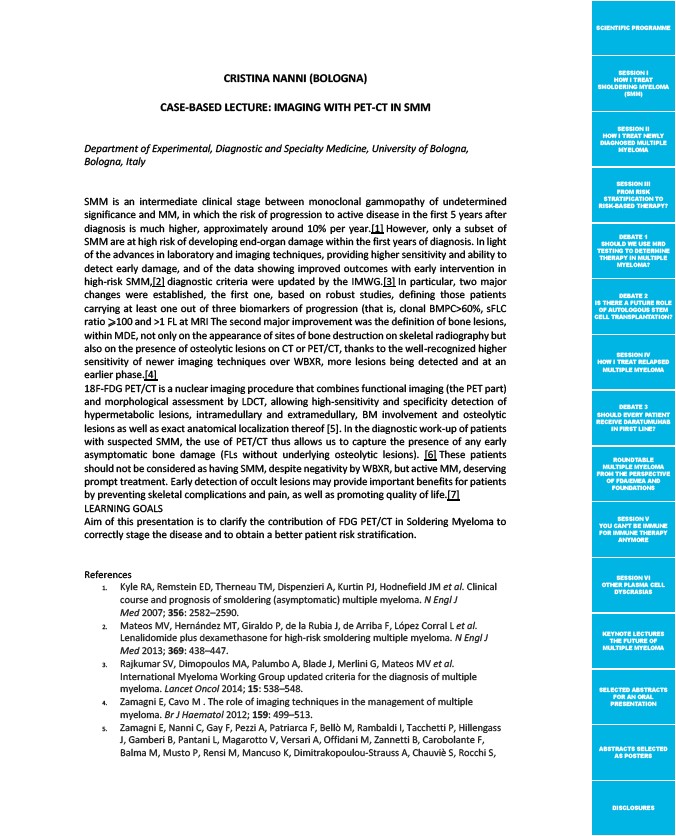
SCIENTIFIC PROGRAMME
SESSION I
HOW I TREAT
SMOLDERING MYELOMA
(SMM)
SESSION II
HOW I TREAT NEWLY
DIAGNOSED MULTIPLE
MYELOMA
SESSION III
FROM RISK
STRATIFICATION TO
RISK-BASED THERAPY?
DEBATE 1
SHOULD WE USE MRD
TESTING TO DETERMINE
THERAPY IN MULTIPLE
MYELOMA?
DEBATE 2
IS THERE A FUTURE ROLE
OF AUTOLOGOUS STEM
CELL TRANSPLANTATION?
SESSION IV
HOW I TREAT RELAPSED
MULTIPLE MYELOMA
DEBATE 3
SHOULD EVERY PATIENT
RECEIVE DARATUMUMAB
IN FIRST LINE?
ROUNDTABLE
MULTIPLE MYELOMA
FROM THE PERSPECTIVE
OF FDA/EMEA AND
FOUNDATIONS
SESSION V
YOU CAN’T BE IMMUNE
FOR IMMUNE THERAPY
ANYMORE
SESSION VI
OTHER PLASMA CELL
DYSCRASIAS
KEYNOTE LECTURES
THE FUTURE OF
MULTIPLE MYELOMA
SELECTED ABSTRACTS
FOR AN ORAL
PRESENTATION
ABSTRACTS SELECTED
AS POSTERS
DISCLOSURES
CRISTINA NANNI (BOLOGNA)
CASE-BASED LECTURE: IMAGING WITH PET-CT IN SMM
Department of Experimental, Diagnostic and Specialty Medicine, University of Bologna,
Bologna, Italy
SMM is an intermediate clinical stage between monoclonal gammopathy of undetermined
significance and MM, in which the risk of progression to active disease in the first 5 years after
diagnosis is much higher, approximately around 10% per year.1 However, only a subset of
SMM are at high risk of developing end-organ damage within the first years of diagnosis. In light
of the advances in laboratory and imaging techniques, providing higher sensitivity and ability to
detect early damage, and of the data showing improved outcomes with early intervention in
high-risk SMM,2 diagnostic criteria were updated by the IMWG.3 In particular, two major
changes were established, the first one, based on robust studies, defining those patients
carrying at least one out of three biomarkers of progression (that is, clonal BMPC>60%, sFLC
ratio ⩾100 and >1 FL at MRI The second major improvement was the definition of bone lesions,
within MDE, not only on the appearance of sites of bone destruction on skeletal radiography but
also on the presence of osteolytic lesions on CT or PET/CT, thanks to the well-recognized higher
sensitivity of newer imaging techniques over WBXR, more lesions being detected and at an
earlier phase.4
18F-FDG PET/CT is a nuclear imaging procedure that combines functional imaging (the PET part)
and morphological assessment by LDCT, allowing high-sensitivity and specificity detection of
hypermetabolic lesions, intramedullary and extramedullary, BM involvement and osteolytic
lesions as well as exact anatomical localization thereof 5. In the diagnostic work-up of patients
with suspected SMM, the use of PET/CT thus allows us to capture the presence of any early
asymptomatic bone damage (FLs without underlying osteolytic lesions). 6 These patients
should not be considered as having SMM, despite negativity by WBXR, but active MM, deserving
prompt treatment. Early detection of occult lesions may provide important benefits for patients
by preventing skeletal complications and pain, as well as promoting quality of life.7
LEARNING GOALS
Aim of this presentation is to clarify the contribution of FDG PET/CT in Soldering Myeloma to
correctly stage the disease and to obtain a better patient risk stratification.
References
1. Kyle RA, Remstein ED, Therneau TM, Dispenzieri A, Kurtin PJ, Hodnefield JM et al. Clinical
course and prognosis of smoldering (asymptomatic) multiple myeloma. N Engl J
Med 2007; 356: 2582–2590.
2. Mateos MV, Hernández MT, Giraldo P, de la Rubia J, de Arriba F, López Corral L et al.
Lenalidomide plus dexamethasone for high-risk smoldering multiple myeloma. N Engl J
Med 2013; 369: 438–447.
3. Rajkumar SV, Dimopoulos MA, Palumbo A, Blade J, Merlini G, Mateos MV et al.
International Myeloma Working Group updated criteria for the diagnosis of multiple
myeloma. Lancet Oncol 2014; 15: 538–548.
4. Zamagni E, Cavo M . The role of imaging techniques in the management of multiple
myeloma. Br J Haematol 2012; 159: 499–513.
5. Zamagni E, Nanni C, Gay F, Pezzi A, Patriarca F, Bellò M, Rambaldi I, Tacchetti P, Hillengass
J, Gamberi B, Pantani L, Magarotto V, Versari A, Offidani M, Zannetti B, Carobolante F,
Balma M, Musto P, Rensi M, Mancuso K, Dimitrakopoulou-Strauss A, Chauviè S, Rocchi S,